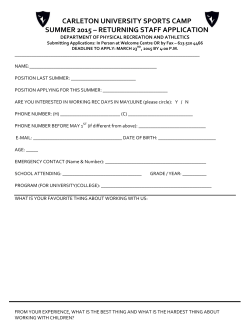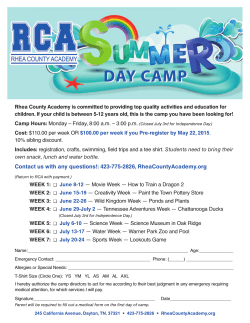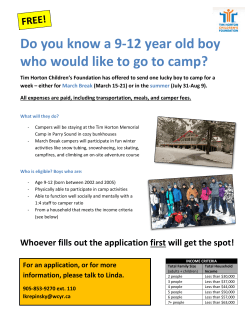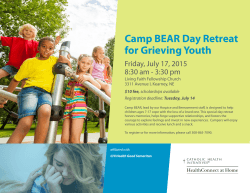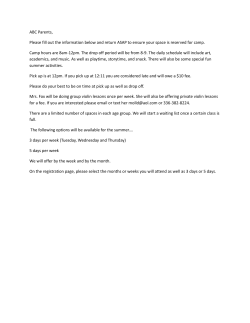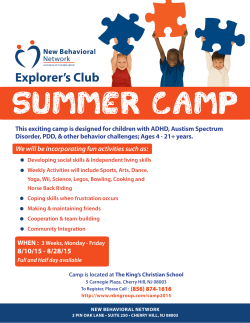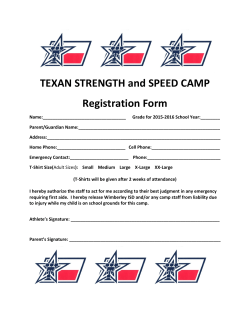
- CSUN ScholarWorks - California State University
Fun with Friends: Evaluating a Summer Camp Experience Shana Morro California State University, Northridge Introduction Camp offers a safe, fun experience for youth that can be a foundation for positive growth and development (Thurber, Bialeschki, Whitaker, Henderson, & Scanlin, 2007) in an environment conducive to children exploring new activities and becoming more adventurous (American Camp Association, 2005) that may be absent in school settings (Merryman, Mezei, Bush & Weinsten, 2012). Purpose • Assess the level of satisfaction that campers experience while attending the AdventureCamp program at AdventurePlex • Explore the relationship between the camper’s age and their level of satisfaction regarding camp activities. Methods Sample / Design • Study participants (N=103) included a convenience sample of youth, male (63.1%) and female (35.9%), ranging in age from 4-12 years old. • Participants attended at least one week of summer day camp at AdventurePlex in Manhattan Beach, California. • One shot case study (XO); survey at the end of the camp week. Concepts / Measures • Self-designed, self-report survey not tested for reliability or validity used to measure activities specific to AdventureCamp. • Concepts of interest included overall camp experience, satisfaction with activities, and youth outcomes (ages 8-12 only). Discussion Results Table 1 Limitations Pearson Product-moment Correlation Between Measures of Overall Camp Satisfaction and Gender and Age • Convenience sample from a single summer day camp. Scale 1 2 3 1. Overall Camp Satisfaction - .115 .213* - .032 2. Gender 3. Younger Campers (ages 4-7) & Older Campers (ages 8-12) - Conclusion * p < 0.05 (2-tailed). • Youth have fun at camp, with the AdventureRoom, Beach, and Field Trips being the most well-liked activities while yoga, songs, and Zumba are the least well-liked activities. There was a small, positive correlation between age and overall satisfaction with camp activities, r = .21, n = 103, p = .03, with older campers associated with higher levels of overall satisfaction with camp activities. Table 2 Pearson Product-moment Correlation Between Measures of Overall Camp Satisfaction and Youth Outcomes Scale 1 1. Overall Camp Satisfaction - 2. Social Development 3. Self-esteem Development Campers Say Which Activity Is The Most Fun? 90 % Of Overall Fun 80 4. Self-explore Development • Study design and measures only allow for participants to respond during one time period and limits the possible range of responses. 2 3 4 5 • Contrary to previous literature, youth self-esteem was not related to camp attendance. The question used in this survey to measure selfesteem was more focused on the self-efficacy motive which refers to the amount that individuals perceive they have the capability of influencing the environment around them (Stets & Burke, 2014). The formulation of the question may have influenced the results. .504** .019 .647** .527** - .220 .641** .621** - .233 .130 - .645** 5. Physical Development - ** p < 0.01 (2-tailed). 70 60 50 40 30 20 10 0 There was a large, positive correlation between youth outcomes and satisfaction, with higher levels of satisfaction associated with increased physical development (r = .53, n = 52, p <0.01), social development (r = .50, n = 52, p <0.01), and self-exploration development (, r = .65, n = 52, p <0.01). References 1. American Camp Association. (2005). Directions: Youth development outcomes of the camp experience. Martinsville, IN: American Camp Association. 2. Merryman, M., Mezei, A., & Weinstein, M. (2012). The effects of a summer camp experience on factors of resilience in at-risk youth. Open Journal of Occupational Therapy, 1(1), 3. 3. Thurber, C., Bialeschki, M., Whitaker, L., Henderson, K. , & Scanlin, M. (2007). Summer camp experiences: Parental perceptions of youth development outcomes. Journal of Family Issues, 28(8), 987-1007. 4. Stets, J., & Burke, P. (2014). Self-esteem and identities. Sociological Perspectives, 57(4), 409-433. www.postersession.com
© Copyright 2025
